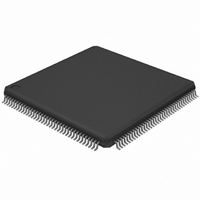LPC2378FBD144,551 NXP Semiconductors, LPC2378FBD144,551 Datasheet - Page 32

LPC2378FBD144,551
Manufacturer Part Number
LPC2378FBD144,551
Description
IC ARM7 MCU FLASH 512K 144LQFP
Manufacturer
NXP Semiconductors
Series
LPC2300r
Datasheet
1.LPC2377FBD144551.pdf
(68 pages)
Specifications of LPC2378FBD144,551
Program Memory Type
FLASH
Program Memory Size
512KB (512K x 8)
Package / Case
144-LQFP
Core Processor
ARM7
Core Size
16/32-Bit
Speed
72MHz
Connectivity
CAN, EBI/EMI, Ethernet, I²C, Microwire, MMC, SPI, SSI, SSP, UART/USART, USB
Peripherals
Brown-out Detect/Reset, DMA, I²S, POR, PWM, WDT
Number Of I /o
104
Ram Size
58K x 8
Voltage - Supply (vcc/vdd)
3 V ~ 3.6 V
Data Converters
A/D 8x10b; D/A 1x10b
Oscillator Type
Internal
Operating Temperature
-40°C ~ 85°C
Processor Series
LPC23
Core
ARM7TDMI-S
Data Bus Width
16 bit, 32 bit
Data Ram Size
58 KB
Interface Type
CAN/I2S/ISP/UART/USB
Maximum Clock Frequency
72 MHz
Number Of Programmable I/os
104
Number Of Timers
4
Operating Supply Voltage
3.3 V
Maximum Operating Temperature
+ 85 C
Mounting Style
SMD/SMT
3rd Party Development Tools
MDK-ARM, RL-ARM, ULINK2, KSDKLPC2378-02, MCB2370, MCB2370U, MCB2370UME
Development Tools By Supplier
OM10094
Minimum Operating Temperature
- 40 C
On-chip Adc
8-ch x 10-bit
On-chip Dac
1-ch x 10-bit
Lead Free Status / RoHS Status
Lead free / RoHS Compliant
For Use With
568-4310 - EVAL BOARD LPC2158 W/LCDMCB2370UME - BOARD EVAL MCB2370 + ULINK-MEMCB2370U - BOARD EVAL MCB2370 + ULINK2MCB2370 - BOARD EVAL NXP LPC2368/2378568-3999 - BOARD EVAL FOR LPC23 ARM MCU622-1005 - USB IN-CIRCUIT PROG ARM7 LPC2K
Eeprom Size
-
Lead Free Status / Rohs Status
Lead free / RoHS Compliant
Other names
568-3998
935282458551
LPC2378FBD144-S
935282458551
LPC2378FBD144-S
Available stocks
Company
Part Number
Manufacturer
Quantity
Price
Company:
Part Number:
LPC2378FBD144,551
Manufacturer:
ADI
Quantity:
2 397
Company:
Part Number:
LPC2378FBD144,551
Manufacturer:
NXP Semiconductors
Quantity:
10 000
NXP Semiconductors
LPC2377_78
Product data sheet
7.25.1.2 Main oscillator
7.25.1.3 RTC oscillator
7.25.2 PLL
7.25.3 Wake-up timer
The main oscillator can be used as the clock source for the CPU, with or without using the
PLL. The main oscillator operates at frequencies of 1 MHz to 25 MHz. This frequency can
be boosted to a higher frequency, up to the maximum CPU operating frequency, by the
PLL. The clock selected as the PLL input is PLLCLKIN. The ARM processor clock
frequency is referred to as CCLK elsewhere in this document. The frequencies of
PLLCLKIN and CCLK are the same value unless the PLL is active and connected. The
clock frequency for each peripheral can be selected individually and is referred to as
PCLK. Refer to
The RTC oscillator can be used as the clock source for the RTC and/or the WDT. Also, the
RTC oscillator can be used to drive the PLL and the CPU.
The PLL accepts an input clock frequency in the range of 32 kHz to 25 MHz. The input
frequency is multiplied up to a high frequency, then divided down to provide the actual
clock used by the CPU and the USB block.
The PLL input, in the range of 32 kHz to 25 MHz, may initially be divided down by a value
‘N’, which may be in the range of 1 to 256. This input division provides a wide range of
output frequencies from the same input frequency.
Following the PLL input divider is the PLL multiplier. This can multiply the input divider
output through the use of a Current Controlled Oscillator (CCO) by a value ‘M’, in the
range of 1 through 32768. The resulting frequency must be in the range of 275 MHz to
550 MHz. The multiplier works by dividing the CCO output by the value of M, then using a
phase-frequency detector to compare the divided CCO output to the multiplier input. The
error value is used to adjust the CCO frequency.
The PLL is turned off and bypassed following a chip Reset and by entering Power-down
mode. PLL is enabled by software only. The program must configure and activate the PLL,
wait for the PLL to lock, then connect to the PLL as a clock source.
The LPC2377/78 begin operation at power-up and when awakened from Power-down and
Deep power-down modes by using the 4 MHz IRC oscillator as the clock source. This
allows chip operation to resume quickly. If the main oscillator or the PLL is needed by the
application, software will need to enable these features and wait for them to stabilize
before they are used as a clock source.
When the main oscillator is initially activated, the wake-up timer allows software to ensure
that the main oscillator is fully functional before the processor uses it as a clock source
and starts to execute instructions. This is important at power on, all types of Reset, and
whenever any of the aforementioned functions are turned off for any reason. Since the
oscillator and other functions are turned off during Power-down and Deep power-down
modes, any wake-up of the processor from Power-down mode makes use of the wake-up
Timer.
The Wake-up Timer monitors the crystal oscillator to check whether it is safe to begin
code execution. When power is applied to the chip, or when some event caused the chip
to exit Power-down mode, some time is required for the oscillator to produce a signal of
All information provided in this document is subject to legal disclaimers.
Section 7.25.2
Rev. 5 — 17 June 2010
for additional information.
Single-chip 16-bit/32-bit microcontrollers
LPC2377/78
© NXP B.V. 2010. All rights reserved.
32 of 68




















